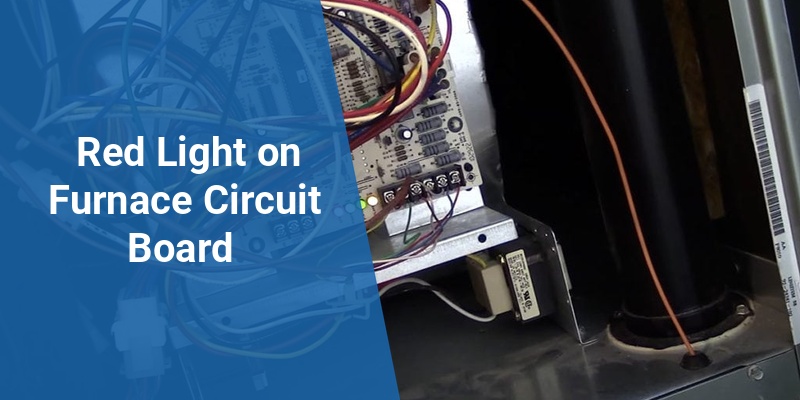When a red light on a furnace circuit board appears, it signals an issue that requires immediate attention to maintain the safe and efficient operation of your heating system. This indicator serves as a troubleshooting guide for HVAC technicians and homeowners alike, helping diagnose common furnace malfunctions. Understanding what the red light means, how to interpret error codes, and how to respond can prevent costly repairs and enhance furnace longevity.
| Error Indicator | Possible Cause | Recommended Action |
|---|---|---|
| Solid Red Light | Ignition failure or safety lockout | Inspect gas supply, reset furnace, call HVAC professional if persists |
| Blinking Red Light | Error code signaling specific faults like flame sensor issues | Count blinks, consult manual for error meaning, perform troubleshooting |
| Alternating Red/Green Light | Normal startup or diagnostic mode | Monitor furnace; if it persists, consult technician |
What Does the Red Light on a Furnace Circuit Board Indicate?
The red light on a furnace circuit board primarily functions as a diagnostic indicator to alert users that the furnace has detected a problem. Most modern furnaces include a control board with one or more LED lights that provide status updates, safety lockout information, or error codes. A solid or blinking red light typically signals malfunctions such as ignition failure, flame loss, overheating, or sensor faults.
This is a critical safety feature designed to prevent damage or hazards by shutting down the furnace automatically when an unsafe condition is detected. Users should not ignore this warning, as continuing to operate a malfunctioning furnace may create further damage or fire risks.
Common Causes for a Red Light on Furnace Circuit Board
There are multiple causes behind a red light appearing on a furnace circuit board. Understanding these helps pinpoint the problem effectively:
- Ignition Failure: The furnace fails to light the burners due to a faulty igniter, gas valve, or blocked gas line.
- Flame Sensor Issues: Dirt or corrosion on the flame sensor may prevent detection, causing the furnace to shut down.
- Limit Switch or High Limit Switch Tripped: Overheating triggers a safety switch that stops the furnace.
- Pressure Switch Malfunction: Faulty venting or blocked air intake can disable this switch.
- Thermostat Malfunction: Improper signals or wiring issues can cause startup failure.
- Wiring or Board Failure: Damaged wiring or a defective control board itself may cause errors and light indicators.
How to Interpret the Furnace Circuit Board Error Codes
Furnace circuit boards commonly use a blinking red light to communicate error codes via a series of blinks. The number and pattern of blinks correspond to specific fault types, which can be found in the furnace’s user or service manual.
For instance, a furnace might flash the red light in the following pattern:
- 3 blinks: Flame sensed when not expected
- 5 blinks: Pressure switch stuck open
- 7 blinks: Flame sensor failure
To decode this:
Call 888-906-9139 for Free Local HVAC Quotes – No Obligation, Just Savings!
- Observe the blinking pattern carefully and count the flashes.
- Pause between groups indicates the separation of error code digits.
- Consult the furnace manufacturer’s guide or label on the furnace door for exact meanings.
Step-by-Step Troubleshooting for Red Light on Furnace Circuit Board
Following a systematic troubleshooting process can resolve many furnace issues linked to the red LED light.
Check Power and Reset Furnace
- Ensure that the furnace is receiving proper electrical power.
- Turn off power to the furnace via the breaker or switch.
- Wait 5 minutes, then restore power to reset the control board and clear temporary faults.
Inspect Air Filters and Vents
- Dirty air filters reduce airflow and can cause overheating.
- Clear any blocked or closed air vents that may restrict airflow or combustion air supply.
Examine Flame Sensor and Igniter
- Locate the flame sensor and gently clean it with fine sandpaper or steel wool to remove buildup.
- Check the igniter for visible cracks or damage; replace if faulty.
Verify Gas Supply
- Confirm that the gas valve is open and the gas supply is uninterrupted.
- Smell for gas leaks or unusual odors and evacuate if a leak is suspected.
Test Pressure and Limit Switches
- Inspect wiring connections for looseness or corrosion.
- Use a multimeter to check switch continuity if qualified to do so.
Consult the Furnace Manual or Contact Professionals
- If the issue persists after these checks, or if error code interpretation is unclear, contact a licensed HVAC technician.
- Never bypass safety switches or ignore persistent error light indications.
Preventative Maintenance to Avoid Furnace Circuit Board Red Alerts
Consistent maintenance reduces the risk of faults triggering a red light on the furnace control board.
- Regular Filter Replacement: Change filters every 1-3 months to maintain airflow.
- Annual Professional Inspection: Certified technicians can check and clean internal components including sensors and wiring.
- Keep Vents and Flues Clear: Ensure there are no blockages in air intake and exhaust systems.
- Monitor for Unusual Noises or Odors: Early detection of abnormalities prevents larger system failures.
When to Call a Furnace Repair Professional
A red light on the furnace circuit board indicates the need for expert diagnosis and repair in many instances, including:
- Repeated lockouts after reset attempts
- Error codes indicating ignition or flame sensor failure
- Suspected gas leaks or electrical hazards
- Obscure or unfamiliar error codes that are not resolved with basic troubleshooting
Prompt action not only restores heating comfort but also ensures the safety of your home and family.
